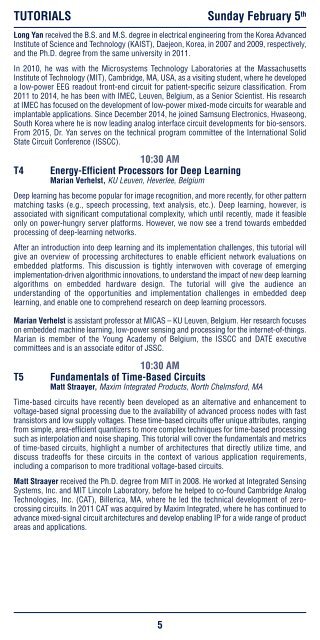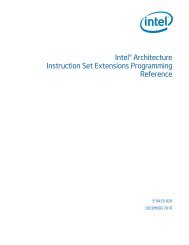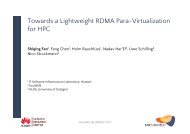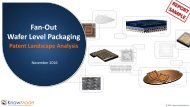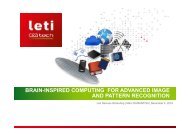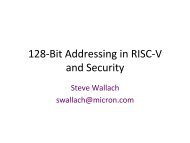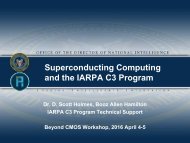PHYSIOLOGICAL-READOUT
ISSCC2017AdvanceProgram
ISSCC2017AdvanceProgram
Create successful ePaper yourself
Turn your PDF publications into a flip-book with our unique Google optimized e-Paper software.
TUTORIALS<br />
Sunday February 5 th<br />
Long Yan received the B.S. and M.S. degree in electrical engineering from the Korea Advanced<br />
Institute of Science and Technology (KAIST), Daejeon, Korea, in 2007 and 2009, respectively,<br />
and the Ph.D. degree from the same university in 2011.<br />
In 2010, he was with the Microsystems Technology Laboratories at the Massachusetts<br />
Institute of Technology (MIT), Cambridge, MA, USA, as a visiting student, where he developed<br />
a low-power EEG readout front-end circuit for patient-specific seizure classification. From<br />
2011 to 2014, he has been with IMEC, Leuven, Belgium, as a Senior Scientist. His research<br />
at IMEC has focused on the development of low-power mixed-mode circuits for wearable and<br />
implantable applications. Since December 2014, he joined Samsung Electronics, Hwaseong,<br />
South Korea where he is now leading analog interface circuit developments for bio-sensors.<br />
From 2015, Dr. Yan serves on the technical program committee of the International Solid<br />
State Circuit Conference (ISSCC).<br />
10:30 AM<br />
T4 Energy-Efficient Processors for Deep Learning<br />
Marian Verhelst, KU Leuven, Heverlee, Belgium<br />
Deep learning has become popular for image recognition, and more recently, for other pattern<br />
matching tasks (e.g., speech processing, text analysis, etc.). Deep learning, however, is<br />
associated with significant computational complexity, which until recently, made it feasible<br />
only on power-hungry server platforms. However, we now see a trend towards embedded<br />
processing of deep-learning networks.<br />
After an introduction into deep learning and its implementation challenges, this tutorial will<br />
give an overview of processing architectures to enable efficient network evaluations on<br />
embedded platforms. This discussion is tightly interwoven with coverage of emerging<br />
implementation-driven algorithmic innovations, to understand the impact of new deep learning<br />
algorithms on embedded hardware design. The tutorial will give the audience an<br />
understanding of the opportunities and implementation challenges in embedded deep<br />
learning, and enable one to comprehend research on deep learning processors.<br />
Marian Verhelst is assistant professor at MICAS – KU Leuven, Belgium. Her research focuses<br />
on embedded machine learning, low-power sensing and processing for the internet-of-things.<br />
Marian is member of the Young Academy of Belgium, the ISSCC and DATE executive<br />
committees and is an associate editor of JSSC.<br />
10:30 AM<br />
T5 Fundamentals of Time-Based Circuits<br />
Matt Straayer, Maxim Integrated Products, North Chelmsford, MA<br />
Time-based circuits have recently been developed as an alternative and enhancement to<br />
voltage-based signal processing due to the availability of advanced process nodes with fast<br />
transistors and low supply voltages. These time-based circuits offer unique attributes, ranging<br />
from simple, area-efficient quantizers to more complex techniques for time-based processing<br />
such as interpolation and noise shaping. This tutorial will cover the fundamentals and metrics<br />
of time-based circuits, highlight a number of architectures that directly utilize time, and<br />
discuss tradeoffs for these circuits in the context of various application requirements,<br />
including a comparison to more traditional voltage-based circuits.<br />
Matt Straayer received the Ph.D. degree from MIT in 2008. He worked at Integrated Sensing<br />
Systems, Inc. and MIT Lincoln Laboratory, before he helped to co-found Cambridge Analog<br />
Technologies, Inc. (CAT), Billerica, MA, where he led the technical development of zerocrossing<br />
circuits. In 2011 CAT was acquired by Maxim Integrated, where he has continued to<br />
advance mixed-signal circuit architectures and develop enabling IP for a wide range of product<br />
areas and applications.<br />
5


